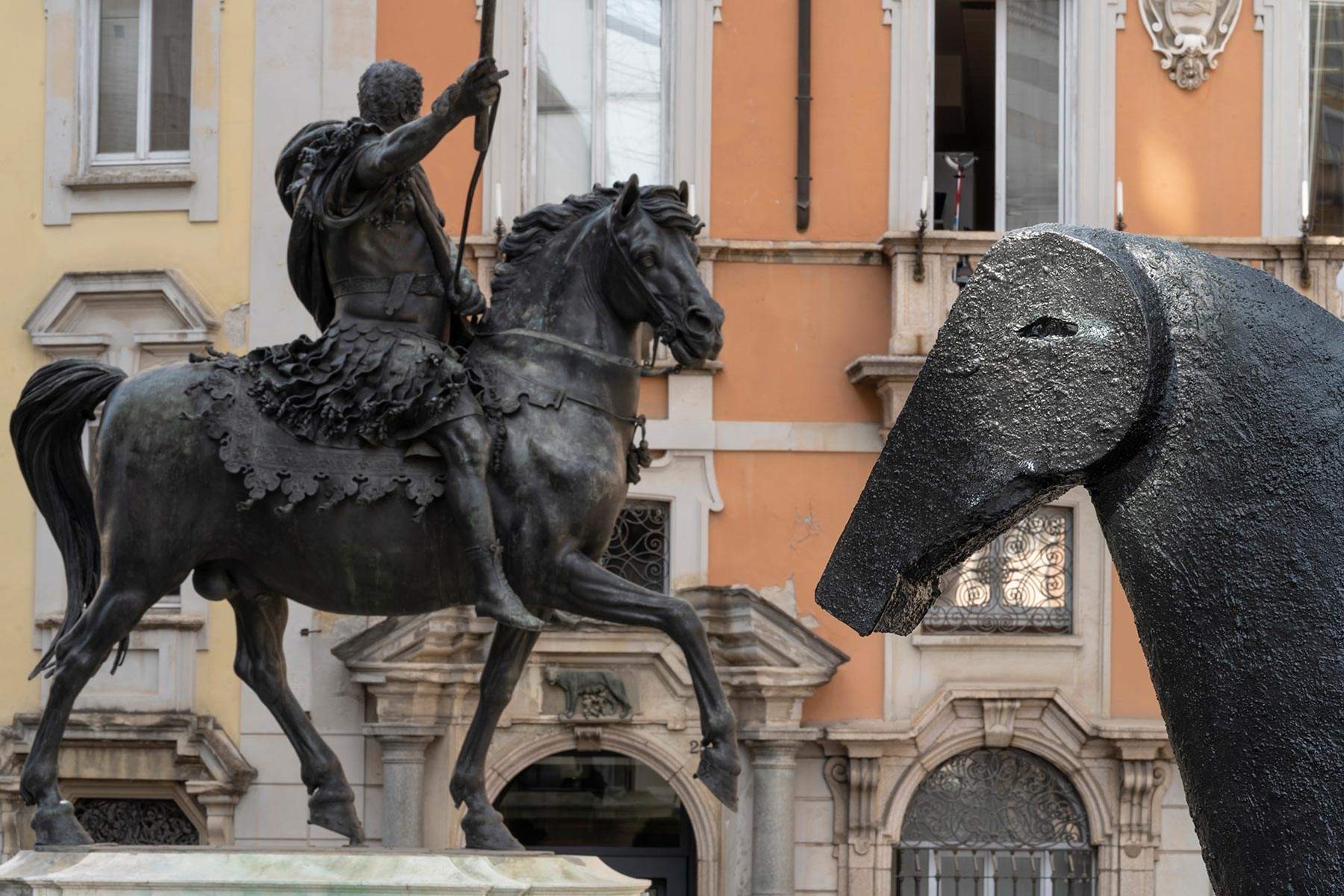Piacenza, horses in confrontation: Paladino "dialogues" with Francesco Mochi in Cavalli Square
Horses Compared in Piacenza, in every sense of the word: from October 10 to December 28, 2020, the PaladinoPiacenza project is on stage in Piazza Cavalli, the main square in the historic center of the Emilian city, featuring a comparison between the equestrian statues of the Farnese dukes made by Francesco Mochi (Montevarchi, 1580 - Rome, 1654) and a site-specific installation by Mimmo Paladino (Paduli, 1948).
The bronze equestrian statues of Alessandro and Ranuccio I Farnese, made by Mochi between 1612 and 1628, are an undisputed masterpiece of Baroque statuary and one of the symbols of Piacenza, and will be made to dialogue with a work specially created by the Campania-based author. Mimmo Paladino’s intervention consists of a monumental installation placed in the center of Piazza Cavalli, equidistant between the two equestrian monuments by Francesco Mochi, and is composed of eighteen fiberglass sculptures placed on a twelve-meter quadrangular base. The subject of the work uses the typically Paladinian icon of a horse redesigned from a funerary model of Etruscan origin that, depending on the contexts, is enriched with Homeric, rural, courtly, and military resonances. The horse, for Paladino, is given as a formal element of passage between the ancient and modern worlds, as well as a place of encounter and clash between the civilizations of East and West. In the case of PaladinoPiacenza, the intention is to interact with the Farnese monuments that give their name to the city’s central square, opposing the pomp of Mochi’s sculptures with the rigor of Paladino’s stylized forms.
PaladinoPiacenza is part of the Piacenza 2020/21 program promoted by a committee composed of the Municipality of Piacenza, the Foundation of Piacenza and Vigevano, the Diocese of Piacenza-Bobbio, and the Chamber of Commerce of Piacenza, in line with the theme Crossroads of Cultures, with which it has applied for the title of Italian Capital of Culture.
“Today’s art,” says Massimo Toscani, president of the Piacenza and Vigevano Foundation, "that which we always call ’contemporary’ for convenience, finds in my opinion its critical fulfillment and cultural affirmation when it is placed in line, if not directly compared, with the works of art of past eras, authoritative witnesses and our interlocutors. From this conviction came the idea of PaladinoPiacenza, that is, to ask master Mimmo Paladino to imagine a work that would stand in dialogue with Francesco Mochi’s Farnese equestrian monuments. I think everyone agrees that ’Our Horses’ is the most outstanding complex in Piacenza’s artistic heritage. It is a work that has no equal in the world and constitutes, with good reason, another Italian primacy, as well as identifying the city starting from its main square: the Piazza dei Cavalli, precisely, the square of civic power as opposed to the nearby (and distant) Piazza del Duomo, the seat of religious power, which, in our city, has never been second to political power."
“Once again,” declares Flavio Arensi, “Paladino proves that he is able to intervene in complex spaces where history is exhibited as a harmonious accumulation and where the contemporary artwork becomes a place of interconnection, in its own ability to create a visual and cultural short-circuit that is completely autonomous. It is, in fact, a peculiar characteristic of Paladino’s language to be able to grasp the general motifs that connote the environment, making free and self-sufficient use of them to build a new narrative in images. As has already happened with other installations, one thinks of the Salt Mountain or the Great Cross in Florence, the work is temporary and remains a kind of ephemeral apparition, a momentary element that assumes in itself the pre-existing conditions. The whole square, then, becomes Paladino’s work, a symphony between the parts and the people who inhabit it.”
“The dialogue triggered by Mimmo Paladino’s intervention in Piazza Cavalli,” says Eugenio Gazzola, “so placed between history and tradition, between art of the past and art of the present, encapsulates in a single event the relationship between the city of Piacenza and the art of our time. ’A long march in the institutions’: nothing better than the famous image coined by the sociologist Rudi Dutschke, leader of the Berlin student movement between 1967 and 1968, renders the idea of the city’s gradual, arduous approach to the art of today. A march that lasted just under forty years to institutions and entities with jurisdiction over the programs, spaces, and resources needed to promote art: institutions such as the City and Province of Piacenza, the Region of Emilia Romagna, the Ricci Oddi Gallery of Modern Art, and the Piacenza and Vigevano Foundation itself. In each of them it was necessary to inoculate interest in a language that is certainly new and complex, but not hostile and above all not ’difficult,’ as people tend to believe a little for fear of contrasts and a little out of laziness and disengagement.”
Pictured: a detail of Mimmo Paladino’s installation. Ph. Lorenzo Palmieri
 |
| Piacenza, horses in confrontation: Paladino "dialogues" with Francesco Mochi in Cavalli Square |
Warning: the translation into English of the original Italian article was created using automatic tools. We undertake to review all articles, but we do not guarantee the total absence of inaccuracies in the translation due to the program. You can find the original by clicking on the ITA button. If you find any mistake,please contact us.





























